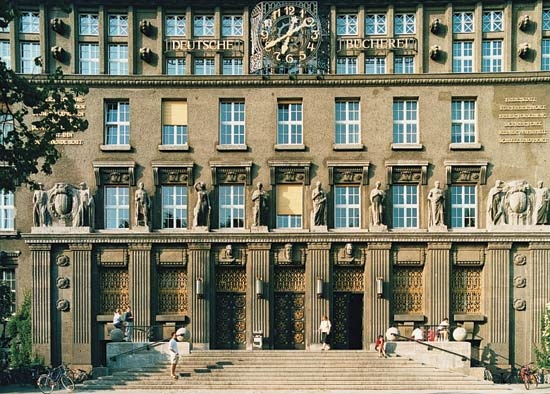Leipzig
Germany
 city, western Saxony Land (state), east-central Germany. It lies just above the junction of the Pleisse, Parthe, and Weisse Elster rivers, about 115 miles (185 km) southwest of Berlin. Leipzig is situated in the fertile, low-lying Leipzig Basin, which has extensive deposits of lignite (brown coal). Although encircled by a belt of parks and gardens, the city is a major industrial centre and transport junction, and it lies at the core of the Halle-Leipzig metropolitan agglomeration. The countryside around the city consists of a plain that is intensively farmed.
city, western Saxony Land (state), east-central Germany. It lies just above the junction of the Pleisse, Parthe, and Weisse Elster rivers, about 115 miles (185 km) southwest of Berlin. Leipzig is situated in the fertile, low-lying Leipzig Basin, which has extensive deposits of lignite (brown coal). Although encircled by a belt of parks and gardens, the city is a major industrial centre and transport junction, and it lies at the core of the Halle-Leipzig metropolitan agglomeration. The countryside around the city consists of a plain that is intensively farmed.Leipzig entered recorded history in AD 1015 as the fortified town of Urbs Libzi and was granted municipal status by 1170. Its favourable position in the middle of a plain intersected by the principal trade routes of central Europe stimulated the town's commercial development. Its two annual markets, at Easter and at Michaelmas (September 29), were raised in 1497 to the rank of imperial fairs. Additional economic privileges enabled Leipzig to become the foremost German commercial centre by about 1700, a development that in turn promoted the growth of a network of roads converging on the town. Leipzig's focal geographic situation had another, less fortunate consequence—several important battles were fought in or near the town. These included two at Breitenfeld (now a suburb) in 1631 and 1642, one at Lützen in 1632 during the Thirty Years' War, and in particular the Battle of Leipzig (Leipzig, Battle of) (or Battle of the Nations) in October 1813 in the Napoleonic Wars.
The town's enviable economic status stimulated a notable cultural life based particularly on the early development of the printing industry but also including the musical efflorescence associated with Johann Sebastian Bach (Bach, Johann Sebastian). Trade continued to be the most important economic activity in the town, with books, furs, yarns, and textiles the primary commodities traded. In 1839 the first German railroad was opened between Leipzig and Dresden, and the accompanying growth of banks provided capital for the city's growing textile and metallurgical industries.
One-fourth of Leipzig was destroyed in the last years of World War II. After the devastation of the war, the restoration and reconstruction of the city were carried out under the communist policies of East Germany. With renewed attention being paid to the Leipzig Fair and other exhibitions held in the city, Leipzig continued to play an important role among European cities. Peaceful but massive demonstrations by citizens of Leipzig in late 1989 played a significant role in bringing an end to the communist regime of East Germany.
The traditional book-publishing and fur industries of Leipzig are still well known. Modern industries include heavy engineering and the manufacture of machinery and motor-vehicle parts. Services are also economically important. The annual Leipzig Fair, held in the spring, is one of the most important forums for international trade between eastern and western Europe. Leipzig is the centre of many railway lines, and its main railway station is one of the most important passenger stations in central Europe and the world's largest dead-end rail station. Leipzig is also the site of Bayerischer Bahnhof, Europe's oldest operating train station. Leipzig is the focus of several major roads, and two airports serve the city.
Historic landmarks were restored after both World War II and German reunification. These include the Old Town Hall, the Old Commercial Exchange, the old residential and market squares, Auerbach's Cellar, and the 13th-century Thomaskirche. The skyline of the modern city now includes the university tower and new hotels and commercial and residential buildings. Within the city, former woodlands along the riverbanks have been partly converted to parks and fulfill an important recreational function.
 Leipzig is a major intellectual and cultural centre. The University of Leipzig (Leipzig, University of) dates from 1409. Leipzig has many museums, and its academies of dramatic art, musical history, graphic arts, and bookmaking are internationally known. Among the city's libraries are the German National Library and the Comenius Library, which is Europe's largest library specializing in education. The University Library, the Leipzig City Library, and the City Archives are also important. Musical traditions are carried on by the Thomaner Choir, the Gewandhaus Orchestra, and the Radio Symphony Orchestra. There is also a fine opera house (1963). Pop. (2003 est.) 497,531.
Leipzig is a major intellectual and cultural centre. The University of Leipzig (Leipzig, University of) dates from 1409. Leipzig has many museums, and its academies of dramatic art, musical history, graphic arts, and bookmaking are internationally known. Among the city's libraries are the German National Library and the Comenius Library, which is Europe's largest library specializing in education. The University Library, the Leipzig City Library, and the City Archives are also important. Musical traditions are carried on by the Thomaner Choir, the Gewandhaus Orchestra, and the Radio Symphony Orchestra. There is also a fine opera house (1963). Pop. (2003 est.) 497,531.- Ginzberg, Louis
- Ginzburg, Natalia
- Ginzburg, Vitaly Lazarevich
- Ginés Pérez de Hita
- Gioachino Rossini
- Gioberti, Vincenzo
- Giocondo, Fra Giovanni
- Gioia del Colle
- Giolitti, Giovanni
- Giono, Jean
- Gio Ponti
- Giordano Bruno
- Giordano, Luca
- Giordano, Umberto
- Giorgi, Giovanni
- Giorgio Armani
- Giorgio Bassani
- Giorgio Caproni
- Giorgio Chinaglia
- Giorgio de Chirico
- Giorgio Manganelli
- Giorgio Morandi
- Giorgione
- Giorgio Santelli
- Giorgio Vasari